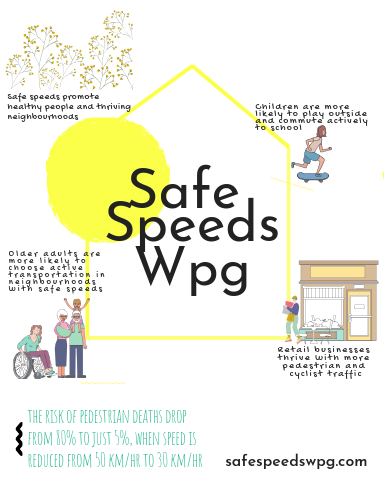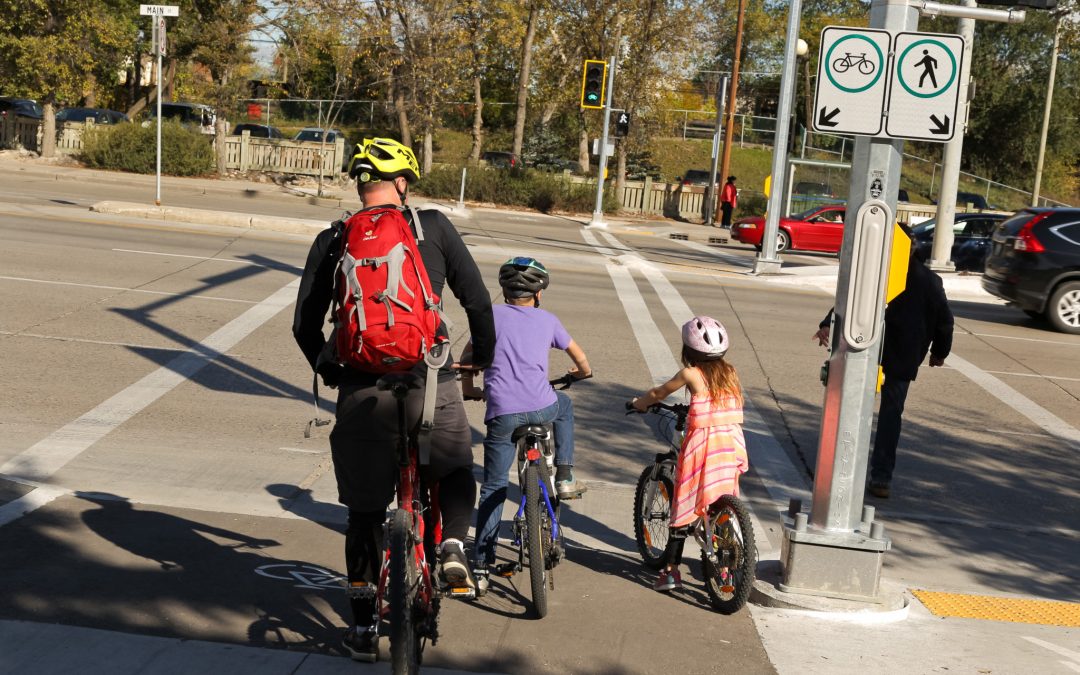The City of Winnipeg has an opportunity to set new default speed limits. New provincial law has made speed limits the responsibility of municipalities. The City of Winnipeg has a new opportunity to set a city-wide speed limit that supports safe, healthy, thriving communities.
30km/h is the only safe speed where people share the road with vehicles. Let’s set a new speed limit for Winnipeg that prioritizes people’s safety and mobility over cars.
Show your support for safe speeds.
Sign the petition. Talk to your neighbours. Tell your City Councillor.

Why 30km/hr?
Risk of pedestrian death drops from 80% to 5% when speeds are reduced from 50km/h to 30km/h
–
Safe speeds promotes healthy people and thriving neighourhoods, where children are more likely to play outside
–
Retail businesses thrive with more cyclist and pedestrian traffic
–
Streets feel safer for people to use healthy & sustainable transportation
- Kids are more likely to walk, bike or roll to school
- Older adults are more able to choose active transportation
Sign the petition, talk to your neighbours, tell your City Councillor.




I am against this idea until you can prove that the 30 zones recently put in place in winnipeg(school zones) have been prover any safer. Majority of fatal pedestrian accidents are in locations which would not be affected by these rules.
Hi Jared,
You raise a good point- it’s very important for us to be data- and research-driven, which is why we refer to the WHO and OECD. I’m not sure the data you are asking for would apply to this case. We think it’s more relevant to look at the effect of consistent speed limits/speed-reduction measures applied across a community or entire city, rather than short segments. We have seen that even simple speed-reduction measures have a significant impact when rolled out on the community level in neighbourhoods with similar characteristics to those in Winnipeg (https://www.cbc.ca/news/canada/calgary/yellow-curb-calgary-permanent-1.5149793). You may be interested in the Community Traffic Study taking place in the Lord Roberts neighbourhood of Winnipeg, which could provide some of the data you’re looking for when complete. (https://winnipeg.ca/publicworks/transportation/projects/lordrobertstraffic.stm). Best practice is to do a pilot project for traffic calming, so that data can be collected before changes are finalized.
We also know that reduced local street speed limits are a factor in the number of children walking or cycling to school. Very few parents I’ve spoken with would allow an 8-year old to walk or cycle to school — or almost anywhere in their community — on their own, and the overwhelming reason parents drive their kids short distances is safety. It doesn’t take a lot of time spent around schools at arrival or dismissal times to see aggressive and dangerous driving behaviours, which CAA has identified as a growing problem (https://www.caa.ca/schoolzonesafety/statistics/). If streets are safe enough for even young children to walk or cycle on, we would see less congestion around schools, healthier kids, and less time spent by parents transporting their kids within the community.
Also, if you’d like to learn more, I would invite you to take a look at our longer blog post on this subject! You may be interested in the data points and precedents: (https://greenactioncentre.ca/featured-asrts/time-for-safe-speeds-in-winnipeg/)